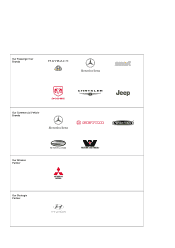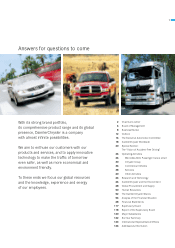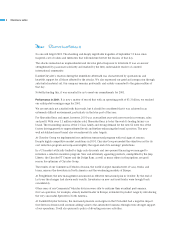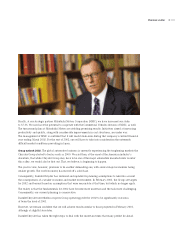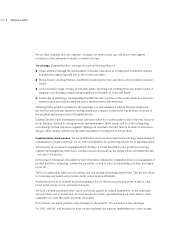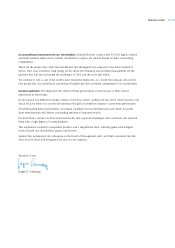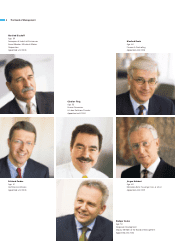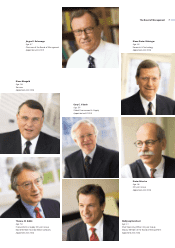Mercedes 2001 Annual Report Download - page 14
Download and view the complete annual report
Please find page 14 of the 2001 Mercedes annual report below. You can navigate through the pages in the report by either clicking on the pages listed below, or by using the keyword search tool below to find specific information within the annual report.
10 Business Review
DaimlerChrysler Aerospace and debis Systemhaus
were partially included in the prior year’s figures. In
addition, TEMIC (Automotive Electronics) and Adtranz
(Rail Systems) were no longer consolidated from April
and May 2001 respectively.
While the Mercedes-Benz Passenger Cars & smart
division was able to increase revenues by 9%, at
Chrysler Group and the Commercial Vehicles division
they were lower than in the prior year. Services’
revenues also declined slightly, but on a comparable
basis there was growth of 12%.
4.5 million vehicles sold. DaimlerChrysler’s unit sales
of 4.5 million vehicles were lower than in the prior year
(4.7 million).
The Mercedes-Benz Passenger Cars & smart divi-
sion performed very well again, with record unit sales
of more than 1.2 million vehicles (+6%), strengthening
its position as the leading brand in the premium
segment. (see pp. 26-29).
Unit sales by Chrysler Group of the Chrysler,
Jeep and Dodge brands fell to 2.8 million vehicles
(2000: 3.0 million). (see pp. 30-33).
Unit sales by the Commercial Vehicles division
of 492,900 trucks, vans and buses were also lower
than the high level of the prior year (549,000).
(see pp. 34-37).
Consolidation phase at Services division. In the period
under review, the Services division focused even more
on sales financing and leasing for the products of the
DaimlerChrysler Group. It achieved total revenues
of €16.9 billion (2000: €17.5 billion). On a comparable
basis (adjusted for the revenues of debis Systemhaus,
which were still included at DaimlerChrysler Services
in the first nine months of the prior year) the division’s
revenues climbed by 12%. Total contract volume of
€131.8 billion reached the level of the prior year ad-
justed for exchange-rate effects, while, as planned, we
limited our new business to €54.9 billion (2000: €56.8
billion). (see pp. 38-39).
Other Activities fulfill expectations. Despite the nega-
tive effects of the terrorist attacks on September 11,
MTU Aero Engines was able to continue its positive
trend of the previous years and achieved further
increases in revenues and earnings. (see pp. 40-41).
EADS should also significantly increase revenues
and earnings in its first full financial year. At the end of
2001, its order backlog climbed to a new peak of
€183.7 billion. With a total of 1,575 aircraft on order,
Airbus further improved its strong position in the world
market for civil aircraft. (see pp. 41-42).
As expected, Mitsubishi Motors’ revenues and
unit sales decreased in the first half of the company’s
2001/2002 financial year (ending on March 31, 2002).
The restructuring measures are being implemented as
planned, and the management expects to break even in
the full 2001/2002 financial year. Mitsubishi Motors’
long-term competitiveness should improve as a result
of an extensive product offensive. (see pp. 42-43).
Concentration on the automotive business. In 2001,
DaimlerChrysler maintained its strategy of focusing on
the automotive business and related services.
In January 2001, we sold the remaining 10% of the
shares of debitel AG to the Swiss telecommunications
company, Swisscom.
On April 3, 2001, the European antitrust authori-
ties approved the sale of Adtranz, our Rail Systems
business unit, to the aeronautics and rail-technology
group, Bombardier. This had been negotiated in August
2000. Adtranz was therefore removed from the
DaimlerChrysler Group’s consolidation effective May 1,
2001.
On April 9, 2001, we agreed to sell an initial 60%
of the shares of TEMIC to Continental. We have an
option to sell the remaining 40% to Continental at an
agreed price between 2002 and 2005. TEMIC was
therefore removed from the consolidated Group
effective April 1, 2001 and has since been included
at equity in line with our 40% stake. With this sale
we have integrated TEMIC into a strong automotive
supplier group with a wide range of products,
increasing its potential for future growth.
In January 2002, we exercised our contractually
agreed option to sell to Deutsche Telekom AG our
49.9% equity interest in T-Systems ITS (formerly debis
Systemhaus AG). The sale of this investment is to be
concluded by March 2002.
Also in January 2002, DaimlerChrysler and GE
Capital agreed that GE Capital would acquire a part of
DaimlerChrysler Services’ capital services portfolio in
the United States. The items to be transferred to GE
Capital consist mainly of commercial real estate and
the asset-based lending portfolio.


